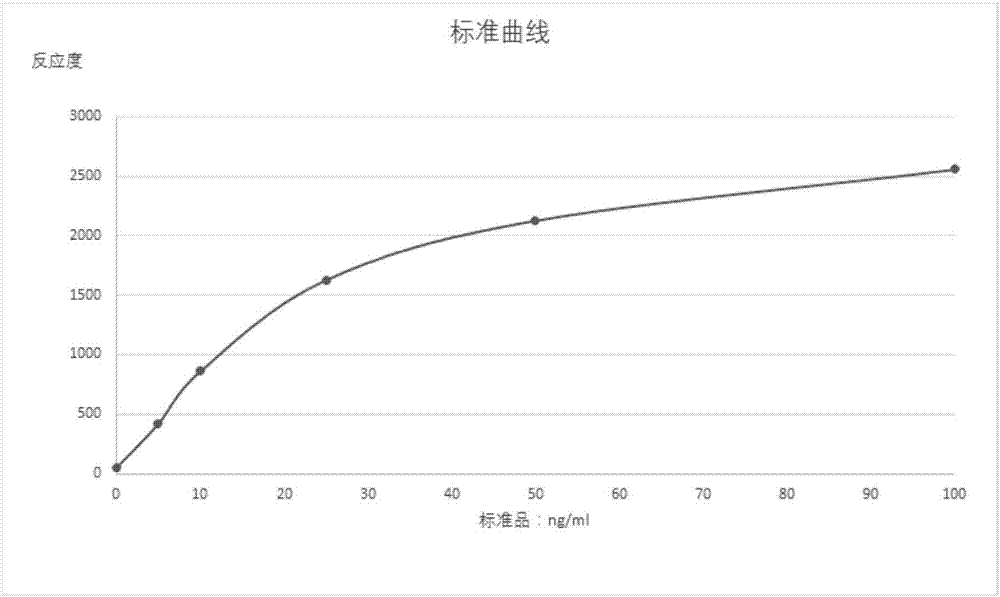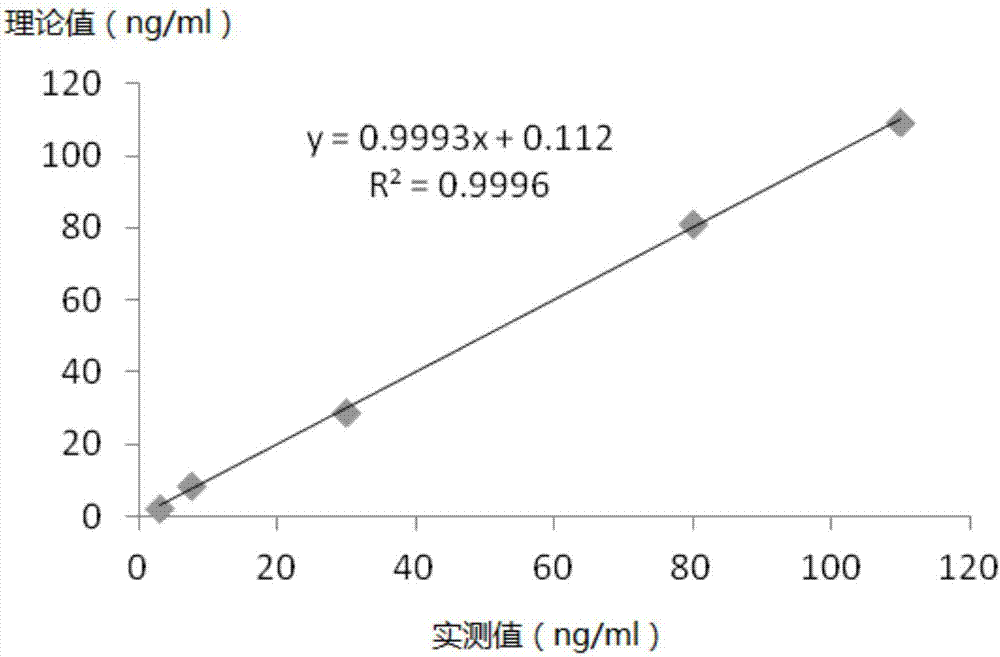Method of rapidly detecting concentration of heparin-combined protein in blood
A heparin-binding protein and blood technology, applied in the field of biomedical diagnosis, can solve problems such as differences in incubation time and different measurement results, and achieve the effect of high accuracy and simple operation
- Summary
- Abstract
- Description
- Claims
- Application Information
AI Technical Summary
Problems solved by technology
Method used
Image
Examples
Embodiment 1
[0027] Example 1 Preparation of anti-human heparin-binding protein monoclonal antibody
[0028] Recombinant human heparin-binding protein is commercially available. Anti-human heparin-binding protein monoclonal antibody was prepared according to the method of reference (Nature, 1975, 256:495-497). Specifically, complete Freund's adjuvant and human heparin-binding protein solution were mixed at a ratio of 1:1 to prepare an emulsion. Female Balb / c mice aged 6-8 weeks were immunized intraperitoneally (100 μl per mouse, containing 10 μg human heparin-binding protein). Two weeks later, the mice were boosted by intraperitoneal injection of 10 μg human heparin-binding protein with incomplete Freund's adjuvant. Two weeks later, blood was taken to determine the titer of antibodies. The mice were boosted by injecting 10 μg of human heparin-binding protein through the tail vein. Four days later, the mice were sacrificed, the spleen cells were isolated, and the isolated spleen cells we...
Embodiment 2
[0029]Example 2 Preparation of anti-human heparin binding protein antibody-latex particle complex
[0030] (1) Activation of latex particles
[0031] Add 100 μl of 10% carboxylated polystyrene latex particle solution into 1.0 mL of 50 mM MES buffer at pH 5.4, mix well, then add 20 μl of 10 mg / mL EDAC, and stir at 37°C Incubate for 0.5-1 hour, centrifuge at 13,000 rpm for 30 minutes, and carefully discard the supernatant. Suspend the pellet in 50 mM PBS buffer, pH 7.4, centrifuge at 13,000 rpm for 30 minutes, carefully discard the supernatant, repeat the washing twice, and finally resuspend the pellet in 1 mL of 50 mM PBS buffer, pH 7.4, to make the final solution The solids percentage of the polystyrene latex particles was 20 mg / ml.
[0032] (2) Selection of cross-linking buffer
[0033] Latex is activated according to step (1), and the latex after thawing is resuspended in MES, MOPOS or PBS damping fluid respectively, and the carboxylated polystyrene latex microsphere solu...
Embodiment 3
[0039] Example 3 Preparation of Heparin Binding Protein Detection Reagent
[0040] (1) Preparation of Reagent 1
[0041] Weigh 6.06g Tris (Tris), 9g NaCl, 40g PEG6000, 0.5mL Tween-20, 0.5gNaN 3 Dissolve in 0.8L deionized water, adjust the pH to 7.4 with dilute hydrochloric acid, and set the volume to 1L to obtain reagent 1. The content of each component in reagent 1 is 0.05mol / L Tris, 0.9% NaCl, 2% PEG6000, 0.05% Tween-20, 0.05% NaN 3 , pH8.0.
[0042] (2) Preparation of reagent 2
[0043] Dilute the antibody-latex particle complex prepared in Example 2 in a certain ratio with Tris-HCl buffer solution with a concentration of 50mM / L, so that the solid content of the floating antibody-latex particle complex is about 0.1-0.25%, adding Add bovine serum albumin BSA to a final concentration of 10 g / L, and add sodium azide to a final concentration of 0.5 g / L to prepare reagent 2.
PUM
| Property | Measurement | Unit |
|---|---|---|
| Particle size | aaaaa | aaaaa |
| Particle size | aaaaa | aaaaa |
Abstract
Description
Claims
Application Information
 Login to View More
Login to View More - R&D
- Intellectual Property
- Life Sciences
- Materials
- Tech Scout
- Unparalleled Data Quality
- Higher Quality Content
- 60% Fewer Hallucinations
Browse by: Latest US Patents, China's latest patents, Technical Efficacy Thesaurus, Application Domain, Technology Topic, Popular Technical Reports.
© 2025 PatSnap. All rights reserved.Legal|Privacy policy|Modern Slavery Act Transparency Statement|Sitemap|About US| Contact US: help@patsnap.com



